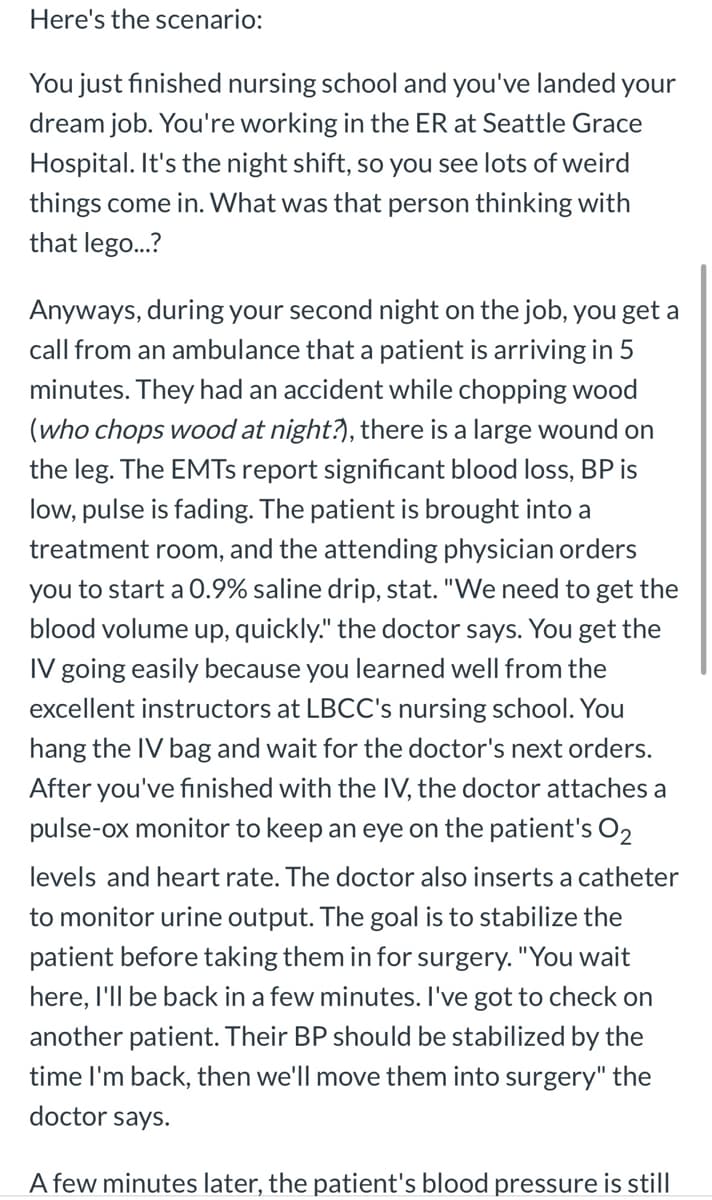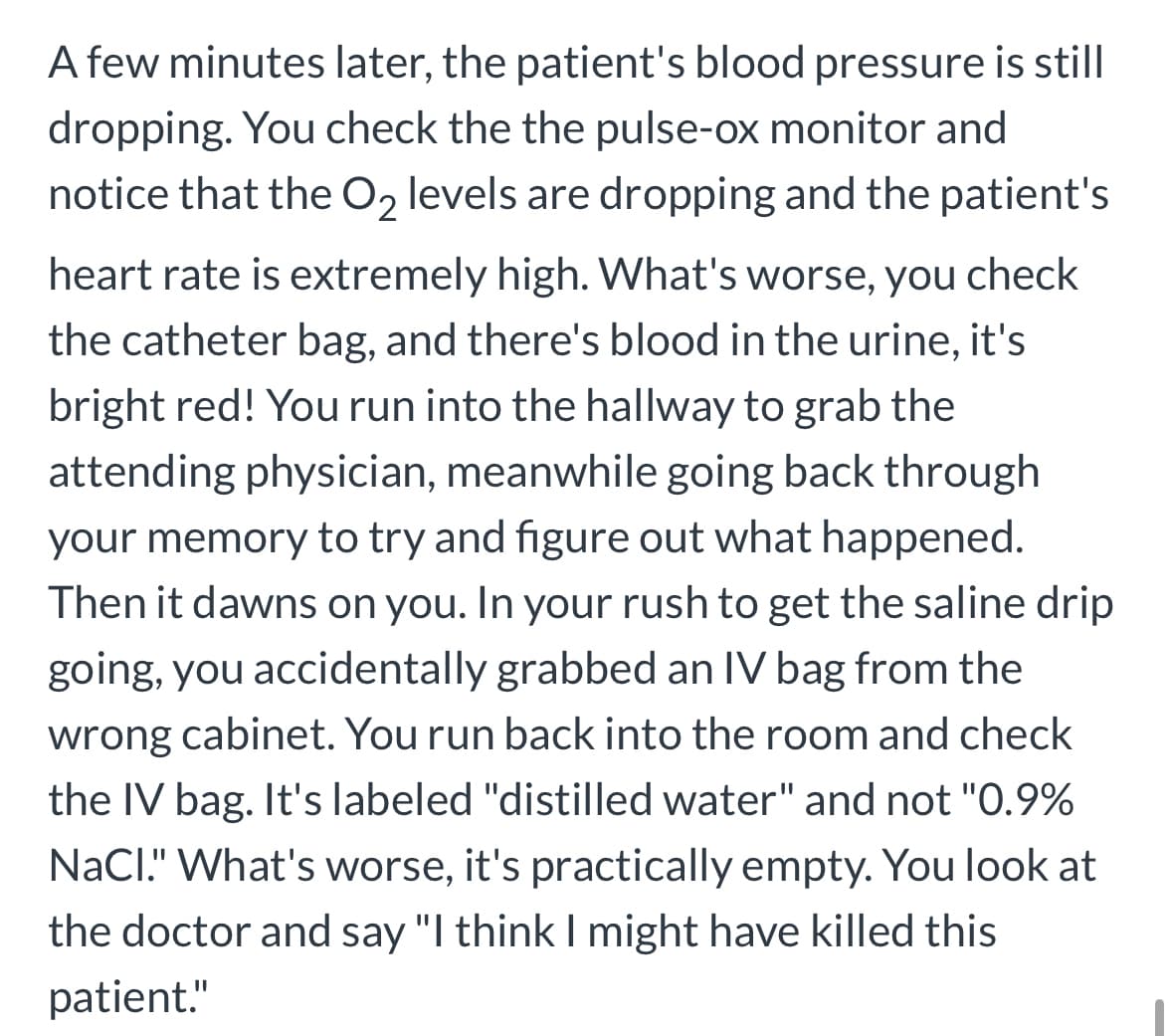A) Why is it a problem that distilled water was used, instead of the saline drip? B) What happened to the patient's red blood cells after the IV with distilled water was used? C) What connection does this have to the patient's O2 levels? (Hint: think about why red blood cells are important) D) Why is a saline drip of 0.9% concentration normally used? E)What type of solution is this concentration, compared to the red blood cells? F) If this was really you, what would your next step be? How could you save this patient? G) On a practical note, can you drink too much water?
A) Why is it a problem that distilled water was used, instead of the saline drip? B) What happened to the patient's red blood cells after the IV with distilled water was used? C) What connection does this have to the patient's O2 levels? (Hint: think about why red blood cells are important) D) Why is a saline drip of 0.9% concentration normally used? E)What type of solution is this concentration, compared to the red blood cells? F) If this was really you, what would your next step be? How could you save this patient? G) On a practical note, can you drink too much water?
Anatomy & Physiology
1st Edition
ISBN:9781938168130
Author:Kelly A. Young, James A. Wise, Peter DeSaix, Dean H. Kruse, Brandon Poe, Eddie Johnson, Jody E. Johnson, Oksana Korol, J. Gordon Betts, Mark Womble
Publisher:Kelly A. Young, James A. Wise, Peter DeSaix, Dean H. Kruse, Brandon Poe, Eddie Johnson, Jody E. Johnson, Oksana Korol, J. Gordon Betts, Mark Womble
Chapter14: The Somatic Nervous System
Section: Chapter Questions
Problem 9ILQ: Visit this site (http://openstaxcollege.org/l/NYTmotor) to read about an elderly woman who starts to...
Related questions
Question
A) Why is it a problem that distilled water was used, instead of the saline drip?
B) What happened to the patient's red blood cells after the IV with distilled water was used? C) What connection does this have to the patient's O2 levels? (Hint: think about why red blood cells are important)
D) Why is a saline drip of 0.9% concentration normally used?
E)What type of solution is this concentration, compared to the red blood cells?
F) If this was really you, what would your next step be? How could you save this patient?
G) On a practical note, can you drink too much water?

Transcribed Image Text:Here's the scenario:
You just finished nursing school and you've landed your
dream job. You're working in the ER at Seattle Grace
Hospital. It's the night shift, so you see lots of weird
things come in. What was that person thinking with
that lego...?
Anyways, during your second night on the job, you get a
call from an ambulance that a patient is arriving in 5
minutes. They had an accident while chopping wood
(who chops wood at night?), there is a large wound on
the leg. The EMTs report significant blood loss, BP is
low, pulse is fading. The patient is brought into a
treatment room, and the attending physician orders
you to start a 0.9% saline drip, stat. "We need to get the
blood volume up, quickly." the doctor says. You get the
IV going easily because you learned well from the
excellent instructors at LBCC's nursing school. You
hang the IV bag and wait for the doctor's next orders.
After you've finished with the IV, the doctor attaches a
pulse-ox monitor to keep an eye on the patient's O2
levels and heart rate. The doctor also inserts a catheter
to monitor urine output. The goal is to stabilize the
patient before taking them in for surgery. "You wait
here, I'll be back in a few minutes. I've got to check on
another patient. Their BP should be stabilized by the
time I'm back, then we'll move them into surgery" the
doctor says.
A few minutes later, the patient's blood pressure is still

Transcribed Image Text:A few minutes later, the patient's blood pressure is still
dropping. You check the the pulse-ox monitor and
notice that the O₂ levels are dropping and the patient's
heart rate is extremely high. What's worse, you check
the catheter bag, and there's blood in the urine, it's
bright red! You run into the hallway to grab the
attending physician, meanwhile going back through
your memory to try and figure out what happened.
Then it dawns on you. In your rush to get the saline drip
going, you accidentally grabbed an IV bag from the
wrong cabinet. You run back into the room and check
the IV bag. It's labeled "distilled water" and not "0.9%
NaCl." What's worse, it's practically empty. You look at
the doctor and say "I think I might have killed this
patient."
Expert Solution
This question has been solved!
Explore an expertly crafted, step-by-step solution for a thorough understanding of key concepts.
Step by step
Solved in 3 steps

Recommended textbooks for you

Anatomy & Physiology
Biology
ISBN:
9781938168130
Author:
Kelly A. Young, James A. Wise, Peter DeSaix, Dean H. Kruse, Brandon Poe, Eddie Johnson, Jody E. Johnson, Oksana Korol, J. Gordon Betts, Mark Womble
Publisher:
OpenStax College

Human Biology (MindTap Course List)
Biology
ISBN:
9781305112100
Author:
Cecie Starr, Beverly McMillan
Publisher:
Cengage Learning

Essentials Health Info Management Principles/Prac…
Health & Nutrition
ISBN:
9780357191651
Author:
Bowie
Publisher:
Cengage

Anatomy & Physiology
Biology
ISBN:
9781938168130
Author:
Kelly A. Young, James A. Wise, Peter DeSaix, Dean H. Kruse, Brandon Poe, Eddie Johnson, Jody E. Johnson, Oksana Korol, J. Gordon Betts, Mark Womble
Publisher:
OpenStax College

Human Biology (MindTap Course List)
Biology
ISBN:
9781305112100
Author:
Cecie Starr, Beverly McMillan
Publisher:
Cengage Learning

Essentials Health Info Management Principles/Prac…
Health & Nutrition
ISBN:
9780357191651
Author:
Bowie
Publisher:
Cengage

Medical Terminology for Health Professions, Spira…
Health & Nutrition
ISBN:
9781305634350
Author:
Ann Ehrlich, Carol L. Schroeder, Laura Ehrlich, Katrina A. Schroeder
Publisher:
Cengage Learning

